

![[Interview with Keiichi Tanaami] Intricately Drawn Lines by Hokusai, Beams of Light from Childhood Memories](/hokusai/filelib/3/1598257255.jpg)
[Interview with Keiichi Tanaami] Intricately Drawn Lines by Hokusai, Beams of Light from Childhood Memories
For more than half a century, artist Keiichi Tanaami has been a driving force on the Japanese art scene. In recent years, his large-scale exhibitions at Ginza Graphic Gallery and other venues have garnered high praise. He has gained support from people of all ages through ambitious projects including collaborations with Adidas and Uniqlo. Now, Keiichi Tanaami has collaborated with artisans who have mastered traditional ukiyo-e production techniques to create a “contemporary ukiyo-e.” We met with Keiichi Tanaami at the contemporary art gallery NANZUKA in Shibuya, Tokyo to ask him about ukiyo-e and woodcut prints.
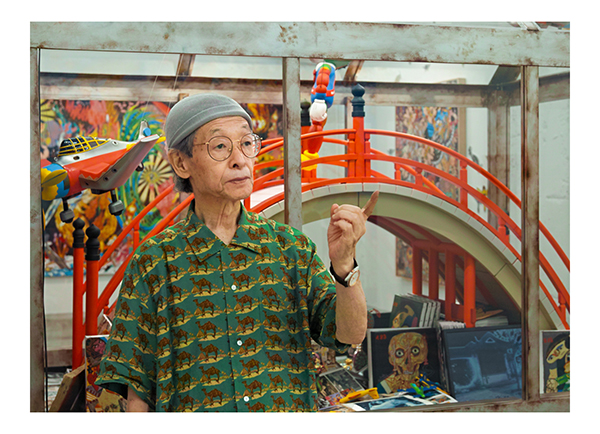 Keiichi Tanaami was born in Tokyo in 1936 and graduated from Musashino Art University. He has been active as a graphic designer, filmmaker, and artist since the 1960s, never heeding the boundaries of mediums or genres but instead aggressively traversing them through his work. The history and trajectory of his practice spanning well over half a century have garnered tremendous support from younger generation of artists around the world, as he is viewed as a new figure of the artist in the 21st century. Last year Tanaami presented his collaboration with adidas Originals “Adicolor x Tanaami.” His active creative activities were also introduced in the television program “Jonetsu Tairiku” aired last April, and gained much attention. In addition, with his works being on permanent exhibit in the Museum of Modern Art New York (MoMA) that celebrated its renewal opening last fall, he continues to receive one and only acclaim as an artist who represents postwar Japan. Tanaami’s recent solo exhibitions include, “No More War” (Schinkel Pavilion, Berlin, 2013) and “Killer Joe’s (1965 – 1975)” (Fondation Speerstra, Switzerland, 2013), with participation in numerous group exhibitions such as “Ausweitung der Kampfzone: Die Sammlung 1968 – 2000” (Neue Nationalgalerie, Berlin, 2013), the large-scale pop art retrospective “International Pop” (Walker Art Center, Dallas Museum of Art, Philadelphia Museum of Art, USA, 2015-2016), “The World Goes Pop” (Tate Modern, London, 2015), and the two-person show “Oliver Payne and Keiichi Tanaami” (Hammer Museum, Los Angeles, 2017), “Keiichi Tanaami” (Kunstmuseum Luzern, Switzerland, 2019), and “Tokyo Pop Underground” (Jeffery Deitch, NY & LA). Furthermore renowned museums around the world such as MoMa (USA), the Walker Art Center (USA), The Art Institute of Chicago (USA), M+ Museum for Visual Culture (Hong Kong), and the National Portrait Gallery (USA), Nationalgalerie im Hamburger Bahnhof (Germany) in recent years have newly welcomed Tannami’s works to their collections.
Keiichi Tanaami was born in Tokyo in 1936 and graduated from Musashino Art University. He has been active as a graphic designer, filmmaker, and artist since the 1960s, never heeding the boundaries of mediums or genres but instead aggressively traversing them through his work. The history and trajectory of his practice spanning well over half a century have garnered tremendous support from younger generation of artists around the world, as he is viewed as a new figure of the artist in the 21st century. Last year Tanaami presented his collaboration with adidas Originals “Adicolor x Tanaami.” His active creative activities were also introduced in the television program “Jonetsu Tairiku” aired last April, and gained much attention. In addition, with his works being on permanent exhibit in the Museum of Modern Art New York (MoMA) that celebrated its renewal opening last fall, he continues to receive one and only acclaim as an artist who represents postwar Japan. Tanaami’s recent solo exhibitions include, “No More War” (Schinkel Pavilion, Berlin, 2013) and “Killer Joe’s (1965 – 1975)” (Fondation Speerstra, Switzerland, 2013), with participation in numerous group exhibitions such as “Ausweitung der Kampfzone: Die Sammlung 1968 – 2000” (Neue Nationalgalerie, Berlin, 2013), the large-scale pop art retrospective “International Pop” (Walker Art Center, Dallas Museum of Art, Philadelphia Museum of Art, USA, 2015-2016), “The World Goes Pop” (Tate Modern, London, 2015), and the two-person show “Oliver Payne and Keiichi Tanaami” (Hammer Museum, Los Angeles, 2017), “Keiichi Tanaami” (Kunstmuseum Luzern, Switzerland, 2019), and “Tokyo Pop Underground” (Jeffery Deitch, NY & LA). Furthermore renowned museums around the world such as MoMa (USA), the Walker Art Center (USA), The Art Institute of Chicago (USA), M+ Museum for Visual Culture (Hong Kong), and the National Portrait Gallery (USA), Nationalgalerie im Hamburger Bahnhof (Germany) in recent years have newly welcomed Tannami’s works to their collections.References to Ukiyo-e and Memories from Childhood Days
——When we see your works, we frequently recognize references to ukiyo-e motifs. In this exhibition, is the drum bridge In the center installation of the venue a motif from ukiyo-e as well?
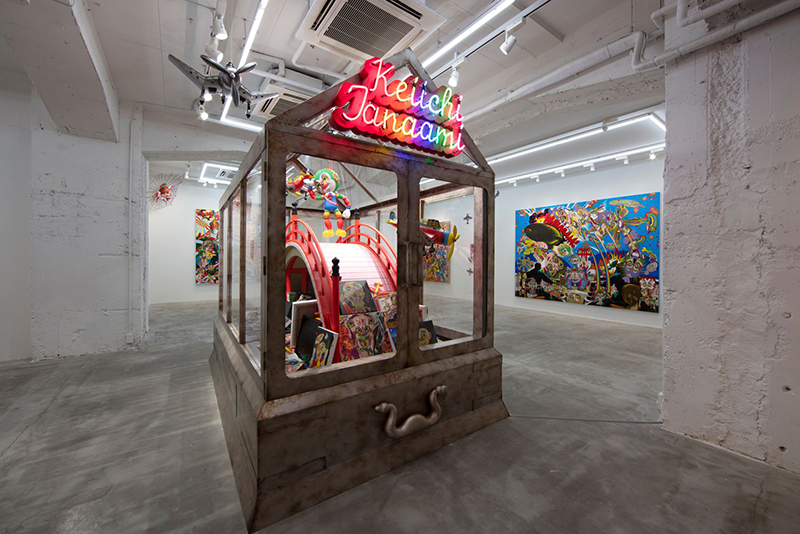
Jul.11 - Aug.8, 2020 / NANZUKA (TOKYO,Japan)(Courtesy of NANZUKA)
“The shape of that drum bridge is a reference to the ukiyo-e by Katsushika Hokusai(1760-1849) entitled "Drum Bridge at Tenjin Shrine, Kameido from the series of Famous Bridges in Various Provinces". The picture is a depiction of the bow-shaped bridge at Kameido Tenjin Shrine, but if a bridge with such steep slopes actually existed, you couldn't actually climb up or walk down it. In other words, this is a representation of ‘a bridge you cannot cross.’ It also connotes an interconnection between the two worlds of life and death.
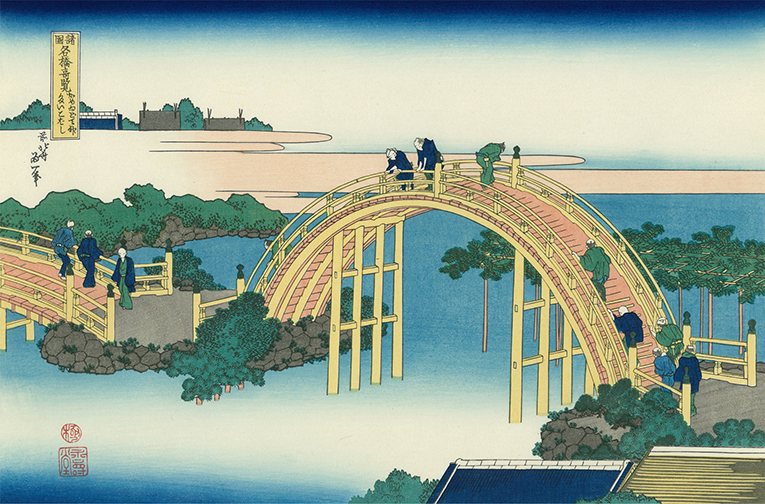
I am fond of bridges, and my image of bridges such as this one originates from the drum bridge at Meguro Gajoen. I used to go to a kindergarten located right by Gajoen. In those days, anyone could freely access Gajoen, so I used to go there from the from kindergarten to play while I waited for my mother to pick me up. The historical building at Gajoen was so luxurious that it was called a ‘Ryugu-jo Palace of the Showa Period’ and housed various interesting Japanese paintings and sculptures, but my favorite was the drum bridge in the restroom.
Later, when I started drawing, I saw various ukiyo-e in books and other places, and I began to tie these childhood memories to the forms I saw in ukiyo-e. By the way, my favorite Hokusai piece with bridges is the one entitled ‘A Hundred Bridges in a Single View’ It is a piece with meticulously detailed renderings of numerous bridges in a Chinese-inspired landscape.”
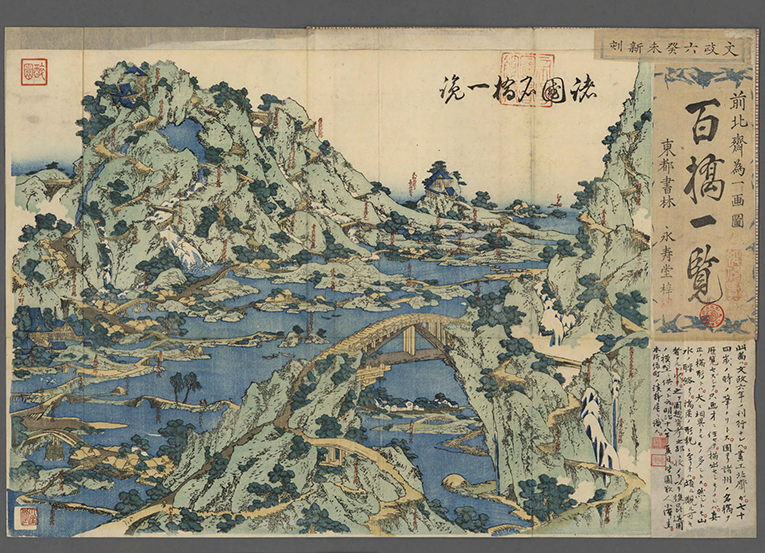
The work by Hokusai mentioned above is an intriguing piece that invites the viewer to explore the intricate landscape. The fact that so many motifs are condensed into a single piece seems to be a feature common to the painstakingly detailed works of Keiichi Tanaami.
“Hokusai-Style Drawing Skills” of Translating Images into Forms
——In addition to bridges, what other motifs from ukiyo-e do you draw on in your work?
“Cherry blossoms and pine trees in my work are also drawn from ukiyo-e, and the way water is depicted as well. Water in Hokusai’s ukiyo-e is expressed in many different ways. I extract parts of those depictions and render them in my own way. My works also include references to Ito Jakuchu(1716-1800) and other artists, but I make references to ukiyo-e most often.
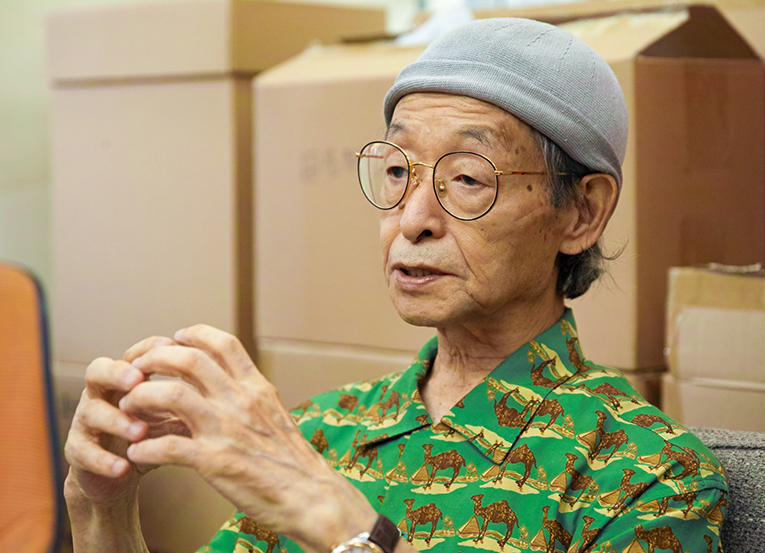
I also like Utagawa Kuniyoshi(1798-1861), Toshusai Sharaku(years of birth and death unknown), but I draw from Hokusai most frequently. First of all, Hokusai drew everything under the sun, and he captured everything in an imaginative way. Also, the lines Hokusai drew are overwhelmingly beautiful. In terms of creating stunning forms, Hokusai stands out from all the other ukiyo-e artists.
Unlike orthodox drawing skills of faithfully capturing the shapes of objects, ‘Hokusai-style drawing skills’ translate the images in one's mind into forms, which I find truly inspiring.”
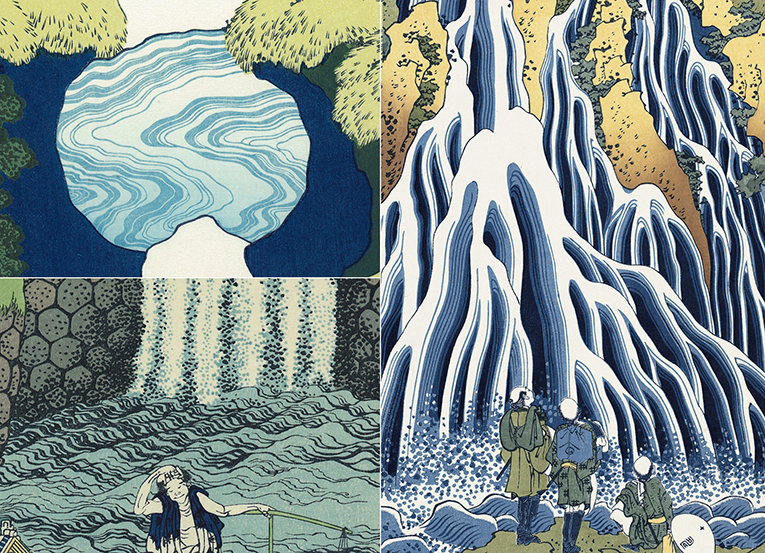
Keiichi Tanaami has said that he makes “references to” these works, but when we see how he depicts waves, for example, we sense that while they retain the essence of ukiyo-e, the lines are unique to the works of Keiichi Tanaami.
We cannot help but marvel at the drawing and composition skills he demonstrates when he digests images from Hokusai in such a way to incorporate them into his own work as parts of the composition. There may be many other references to ukiyo-e that our editorial department has not yet found, which makes us even more excited to see his other works.
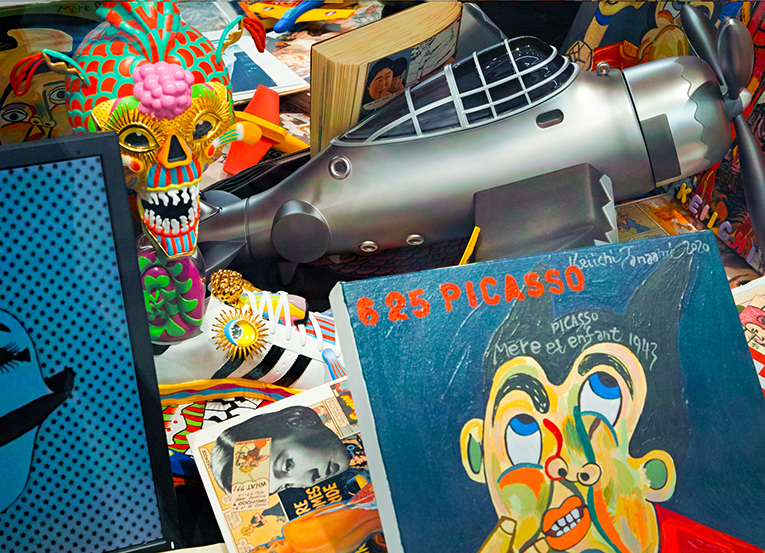
Admiring the Beams of Light Stretching Out into the Darkness
——Next, we would like to ask you about the woodcut print “Eye Beam” that you recently completed. We noticed that you often depict beams of light in your work, including this one.
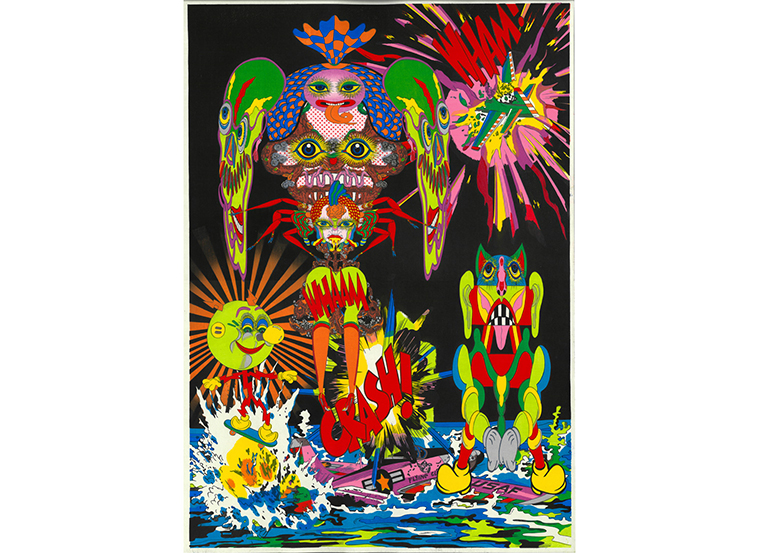
“I experienced air raids as a child. As I rushed to an air-raid shelter with my mother, I saw searchlights of the Japanese military illuminating American B-29 bombers. The multiple streaks of light cutting through the night sky fascinated me.
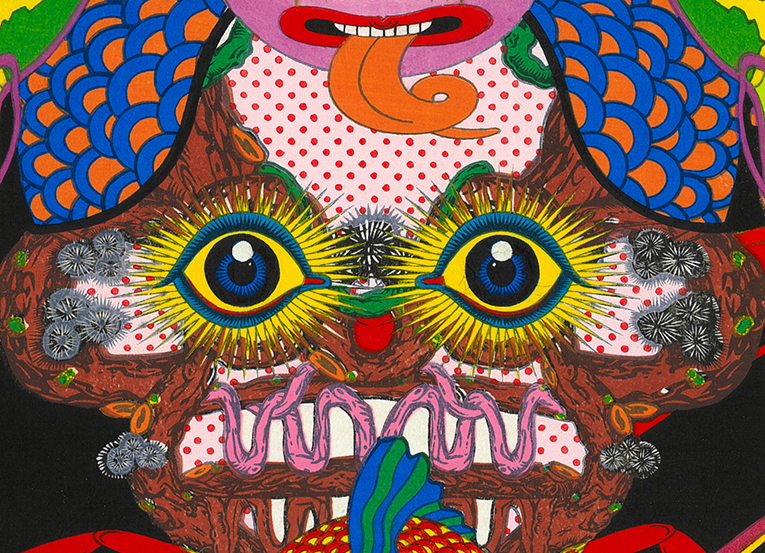
I could sense from the grown-ups around me that we were in danger, but I think I was too young to realize the direness of the situation. Even after I became an adult, I often remembered those beams of light stretching out into the darkness. I think that experience is the origin of the beams in my work.
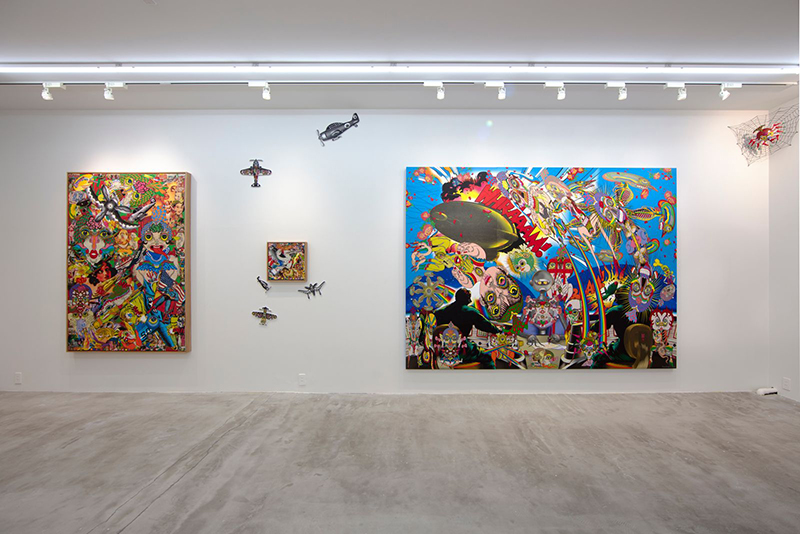
Jul.11 - Aug.8, 2020 / NANZUKA (TOKYO,Japan)(Courtesy of NANZUKA)
I may also have been influenced by the photographs of Nazi Party conventions that I saw as a child. The powerful searchlights pointed upwards around the assembly area were a famous aesthetic feature. It was years later that I learned about the Nazis and Hitler, but as a young child, I saw the pillars of light in the night sky and thought they were beautiful.”
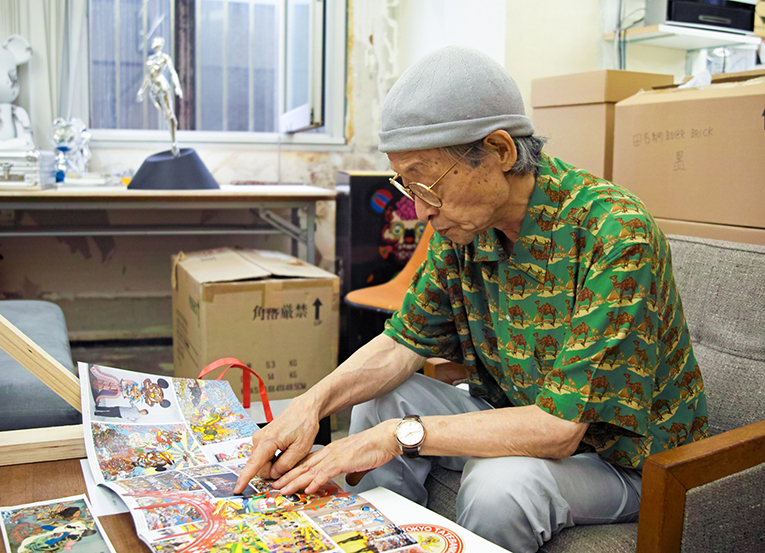
The Intrigue of Creating Contemporary Ukiyo-e
——The woodcut print “Eye Beam” was produced by carvers and printers who have mastered ukiyo-e production techniques from the Edo Period. It is a so-called “contemporary ukiyo-e” . What do you think is the appeal of such a woodcut print?
“I find it intriguing that woodcut prints are more dependent on the skills of artisans in terms of the colors and lines than other types of prints such as silk-screen prints. In the past, one of my works was created as a woodcut print in the style of ‘yakusha-e’ (ukiyo-e woodcut prints of kabuki actors), for example. For this piece, however, I was not particularly conscious about following ukiyo-e styles. I want people to see how my own style is translated into a woodcut print.
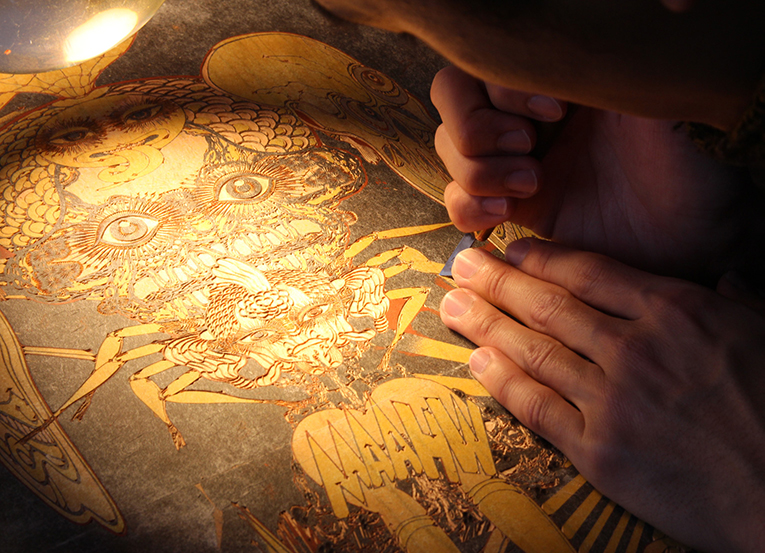
My Instagram account (@keiichitanaami_official) now has 64,000 followers, and about two-thirds of my followers are from abroad. Many of them are young people. I think people overseas are more aware of the ukiyo-e motifs in my works. But I think woodcut prints themselves may be new for many people as well.”
When a photograph of “Eye Beam” was posted on the Keiichi Tanaami official Instagram account, many commented, saying, “I want this” or "Where can I buy this?" It would be wonderful if this piece introduced young fans to the world of ukiyo-e and woodcut prints.
“Floating World” of Keiichi Tanaami – The Floating Sensation of Moving Pictures
——A foreign book about ukiyo-e explained the word “UKIYO-E” by describing the world view of a “Floating World (ukiyo).” The phrase “Floating World” seems to resonate with the floating sensation of your works. What do you think?
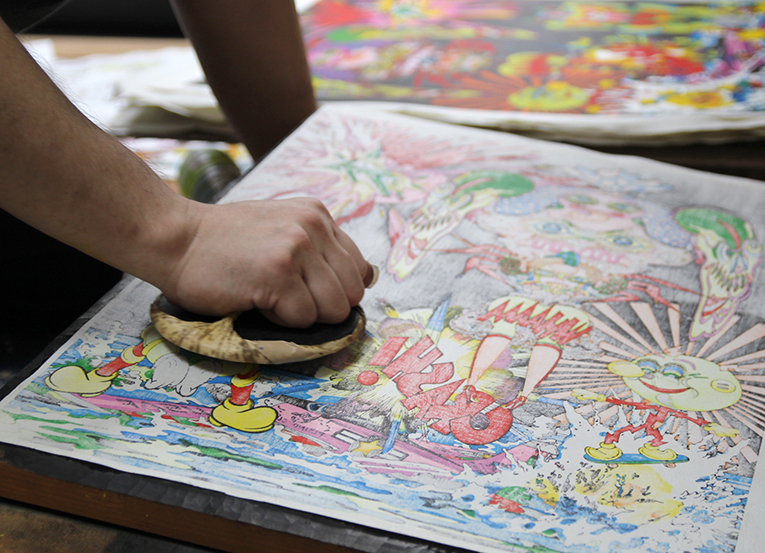
“Perhaps because I loved animation since I was a child, when I draw a picture, I am always conscious about how each element will move in the next instant. Perhaps it is more unconscious than conscious. Each element starts to move on its own, and I see how the next scene develops in my mind's eye. It could be that this gives a certain floating sensation to my work, or a sense of movement in the picture.
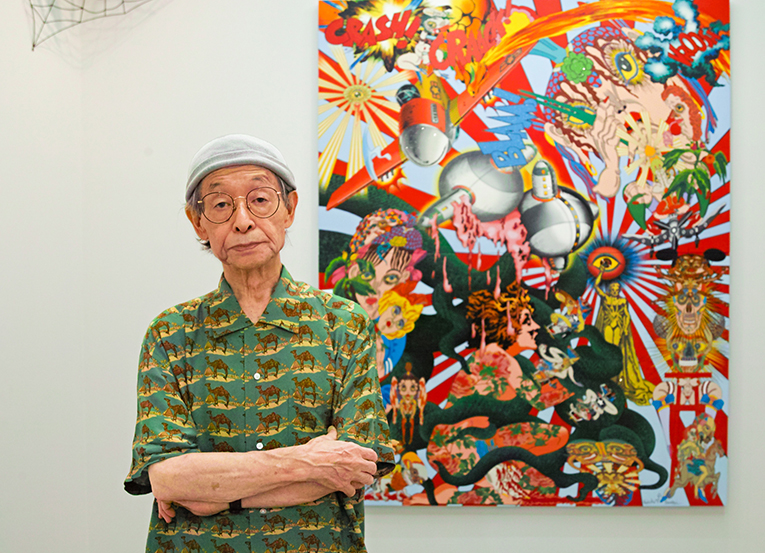
I think I am also influenced by manga. I hope to create the effect of distilling multiple frames of a manga in a single picture. In my case, I always see images moving in my mind when I draw pictures, so creating moving images is an easy transition. I am presently producing video images for an exhibition at the Contemporary Art Museum Kumamoto scheduled to open next year.”
Perhaps it is because the worlds he portrays in his works never stay still that we never tire of looking at the works of Keiichi Tanaami. The woodcut print “Eye Beam” releasing at this time is also a work in which multiple stories unfold simultaneously in various parts of the picture. Although scenes such as the exploding military aircraft create a tense atmosphere, the light and airy feel of a woodcut print gives an unexpected cheerfulness to the piece, revealing a new dimension of the works of Keiichi Tanaami.
Mr. Tanaami, thank you very much for taking time out of your busy schedule to talk to us. We are excited to see your continued success in the future.
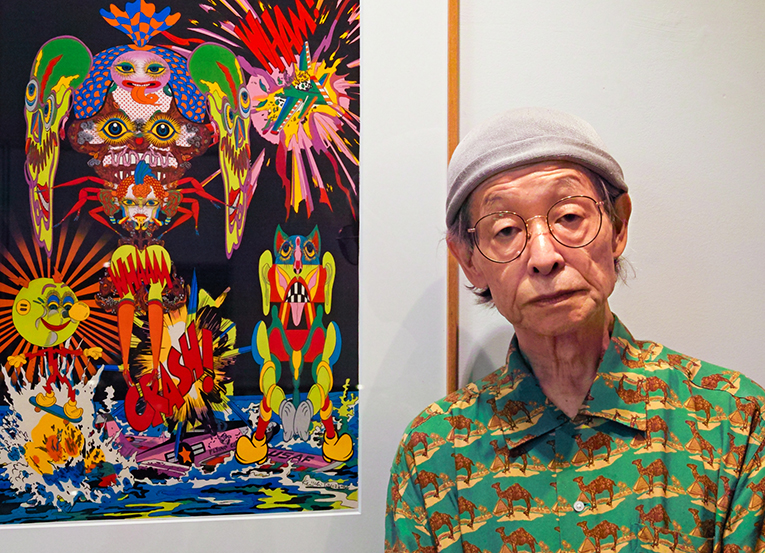
Exhibitions and New Works by Keiichi Tanaami
Date: August 18 (Tue.) – September 12 (Sat.) 2020
Holidays: Sundays, Mondays, public holidays
Business Hours: 11: 00 a.m. – 7 p.m.
Venue: NANZUKA (B2F Shibuya IBIS Building, 2-17-3 Shibuya, Shibuya-ku, Tokyo)
NANZUKA website
Limited Edition: 100
Dimension of picture: 56.5 x 39.7 cm
Type of print: Woodcut print
Paper used: Echizen kizuki hosho washi (produced by living national treasure Ichibei Iwano)
Date of publication: July 2020
Special bonus: 1 proof print (with the artist's autograph and serial number)
Production: The Adachi Institute of Woodcut Prints
Supervision: The Adachi Foundation for the Preservation of Woodcut Printing
For more information about “Eye Beam”
Cooperation: NANZUKA
Text: Mirai Matsuzaki
Photos (unless otherwise specified): Kenji Mori
- Share:
- Tweet
